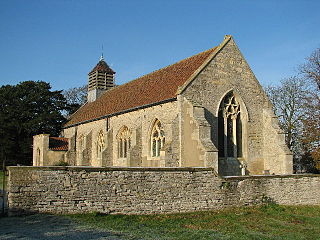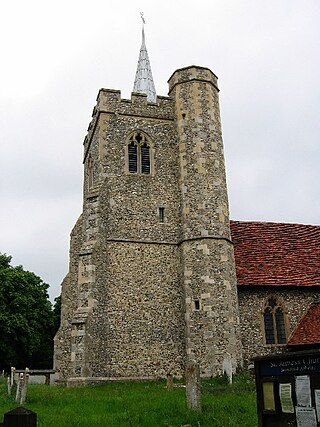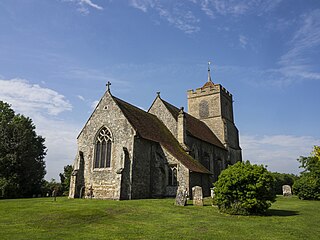
Battlesden is a hamlet and civil parish in the Central Bedfordshire district of Bedfordshire, England. It is just north of the A5, between Dunstable and Milton Keynes. According to the 2001 census, it had a population of 38. Because of its low electorate, it has a parish meeting rather than a parish council. It is in the civil parish of Milton Bryan.

St James' Church is in the village of Gawsworth, Cheshire, England, and is sited near Gawsworth Hall. It is recorded in the National Heritage List for England as a designated Grade I listed building. It is an active Anglican parish church in the diocese of Chester, the archdeaconry of Macclesfield and the deanery of Macclesfield. Clifton-Taylor includes it in his list of 'best' English parish churches. The authors of the Buildings of England series describe the church as being "pretty, but odd".

All Saints Church is in the small village of Weston-on-Avon, Warwickshire, England. The church is recorded in the National Heritage List for England as a designated Grade I listed building. It is an active Anglican parish church in the diocese of Gloucester, the archdeaconry of Cheltenham and the deanery of the North Cotswolds. Its benefice 'RiverVale Churches' is combined with those of St Peter's, Welford, St Swithin's, Quinton and St James The Great, Long Marston, Warwickshire.

The Church of Saint Andrew is an Anglican parish church located on Turnhill Road, in High Ham, Somerset, England. It shows evidence of 12th- and 14th-century building and was largely rebuilt in 1476. On 17 April 1959, it was designated as a Grade I listed building.

St Michael and All Angels Church is a redundant Anglican church in the village of Edmondthorpe, Leicestershire, England. It is recorded in the National Heritage List for England as a designated Grade I listed building, and is under the care of the Churches Conservation Trust.

All Saints Church is a redundant Anglican church in the village of Beeby, Leicestershire, England. It is recorded in the National Heritage List for England as a designated Grade II* listed building, and is under the care of the Churches Conservation Trust.

St Michael's Church is a redundant Anglican church in the village of Cotham, Nottinghamshire, England. The building dates back to the 12th century.

All Saints' Church is a redundant Anglican church in the village of Icklingham, Suffolk, England. It is recorded in the National Heritage List for England as a designated Grade I listed building, and is under the care of the Churches Conservation Trust. The church stands in the highest point in the village, adjacent to the A1101 road between Mildenhall and Bury St Edmunds. This was formerly the ancient trackway of Icknield Way, and Icklingham is close to an important junction on this trackway.

St Michael's Church is a redundant Anglican church in the village of Burwell, Lincolnshire, England. It is recorded in the National Heritage List for England as a designated Grade I listed building, and is under the care of the Churches Conservation Trust. It stands on a hillside by the A16 road as it passes through the village.

All Saints Church, Saltfleetby, is a redundant Anglican church in the village of Saltfleetby All Saints, Lincolnshire, England. It is recorded in the National Heritage List for England as a designated Grade I listed building, and is under the care of the Churches Conservation Trust. The church stands in the marshland of Lincolnshire, and has a leaning west tower.

St James' Church is a redundant Anglican church near the village of Stanstead Abbotts, Hertfordshire, England. It is recorded in the National Heritage List for England (NHLE) as a Grade I listed building, having been designated in 1967. The church is under the care of the Churches Conservation Trust. The church is about 1 mile (1.6 km) to the southeast of the village on the north side of the B181 road. It stands on the top of a hill overlooking the Lea marshes.

All Saints’ Church is a redundant Anglican church in the village of Theddlethorpe All Saints, Lincolnshire, England. It is recorded in the National Heritage List for England as a designated Grade listed building, and is under the care of the Churches Conservation Trust. The church stands to the east of the A1031 road in the area of the village named Theddlethorpe All Saints, and is some 3 miles (5 km) northeast of Mablethorpe. It has been called the "Cathedral of the Marsh".

All Saints Church is a redundant Anglican church in the village of Little Wenham, Suffolk, England. It is recorded in the National Heritage List for England as a designated Grade I listed building, and is under the care of the Churches Conservation Trust. It stands in an isolated position close to Little Wenham Hall, about 0.6 miles (1 km) to the northwest of Capel St. Mary.

St Andrew's Church is a redundant Anglican church in the village of Buckland, Hertfordshire, England. It is recorded in the National Heritage List for England as a designated Grade II* listed building, and is under the care of the Churches Conservation Trust. The church stands at the highest point in the village to the east of Ermine Street, now the A10 road, between Royston and Buntingford.

St Laurence's Church is in Union Street, Chorley, Lancashire, England. It is an active Anglican parish church in the deanery of Chorley, the archdeaconry of Blackburn, and the diocese of Blackburn. The church is recorded in the National Heritage List for England as a designated Grade II* listed building.

All Saints' Church is in Queens Road, Hertford, Hertfordshire, England. It is an active Anglican parish church in the deanery of Hertford and Ware, the archdeaconry of Hertford, and the diocese of St Albans. It is the civic church of the town and of the county. The church is recorded in the National Heritage List for England as a designated Grade II* listed building. It is the largest church in Hertfordshire, other than St Albans Cathedral, and can seat up to 1,000 people.

All Saints is a parish church in Ulcombe, Kent. It was begun in the 12th century and is a Grade I listed building.

The Church of St Mary the Virgin is the Church of England parish church of Letchworth in Hertfordshire. A church appears to have been on the site since before the Norman Conquest. The current church was built in the late 12th century and is Grade II listed. It comes under the Diocese of St Albans. The original dedication of the church is unknown; it was rededicated to St Mary during the First World War.

The Church of St Nicholas is a Church of England parish church in the village of Hinxworth in Hertfordshire and is a Grade II* listed building dating mostly to the 14th century. The church comes under the Diocese of St Albans.

St Peter's Church is the parish church of Dalby, North Yorkshire, a village in England.

























